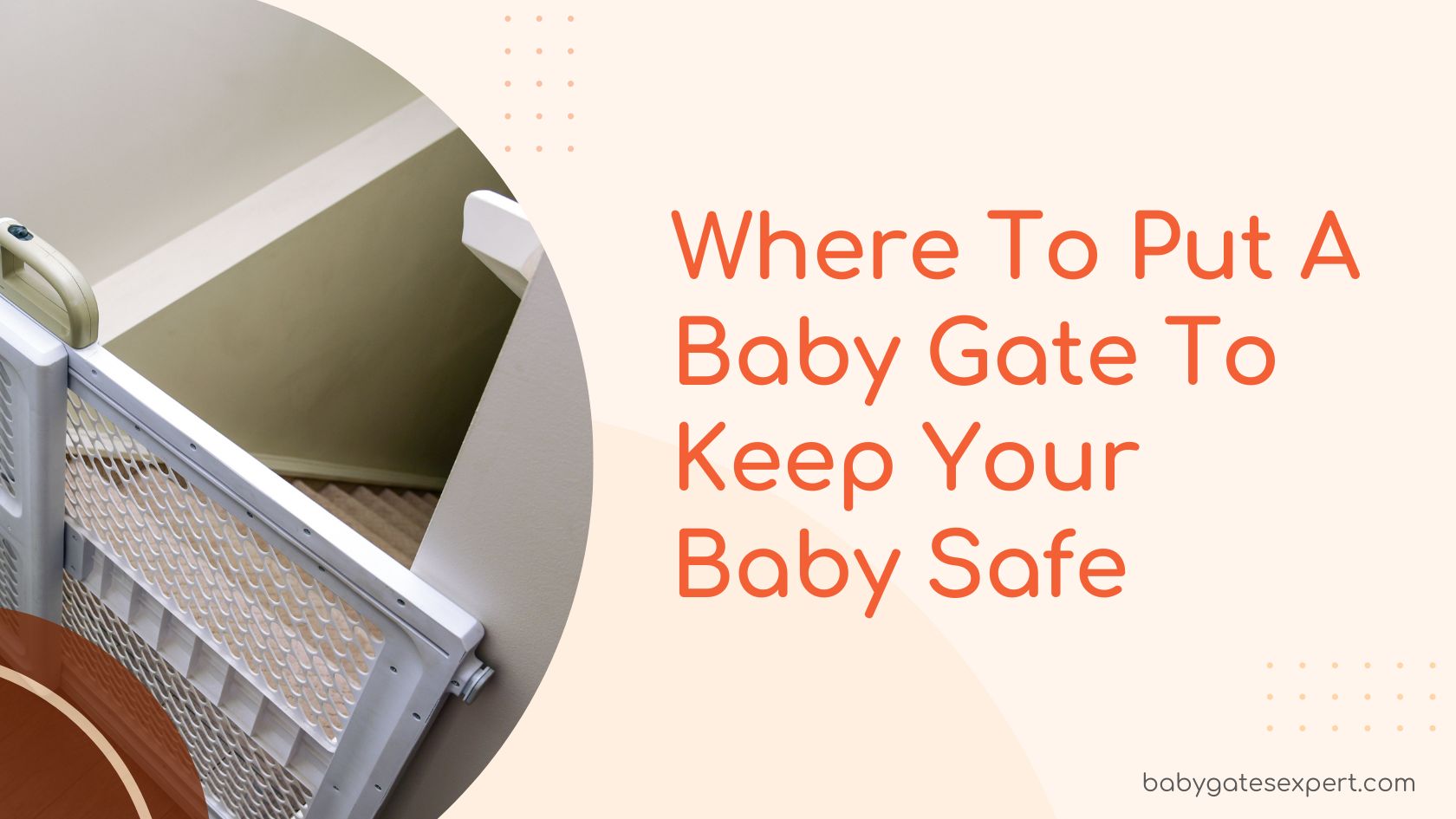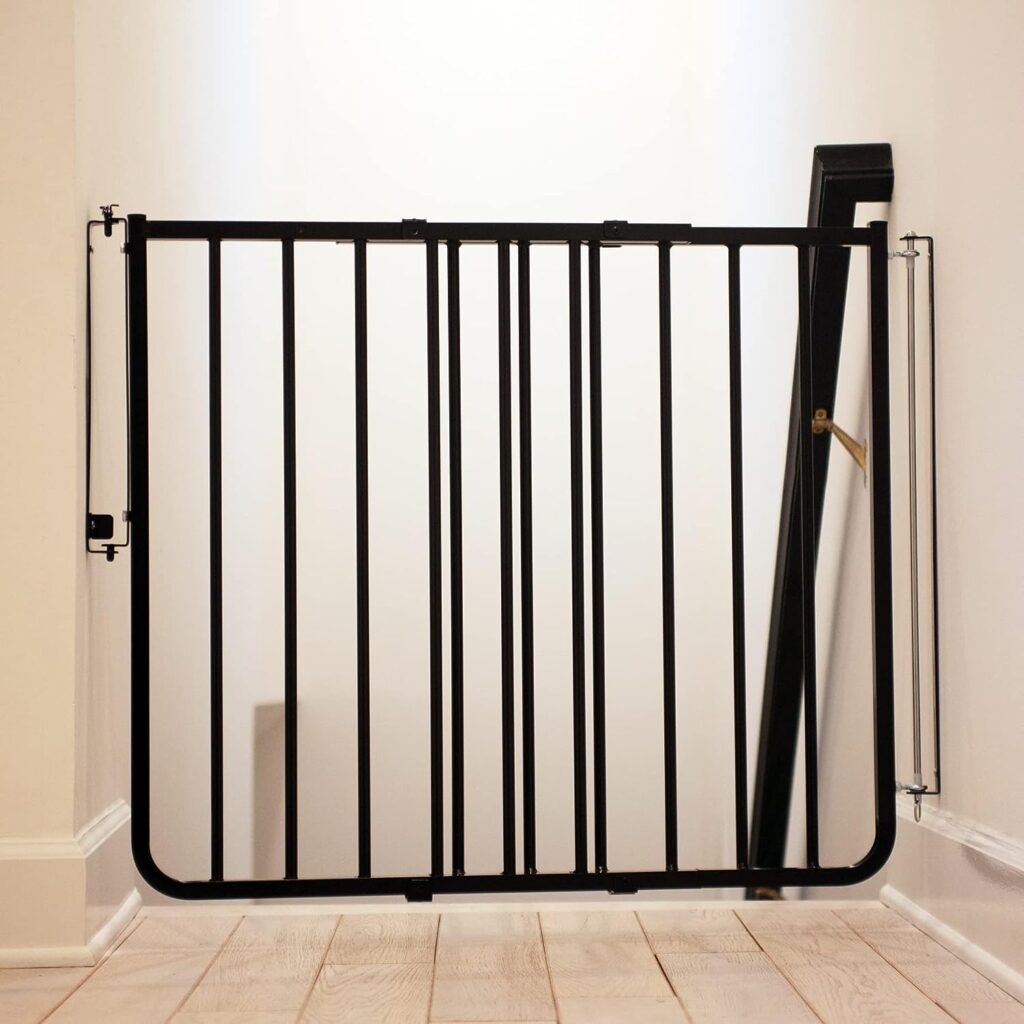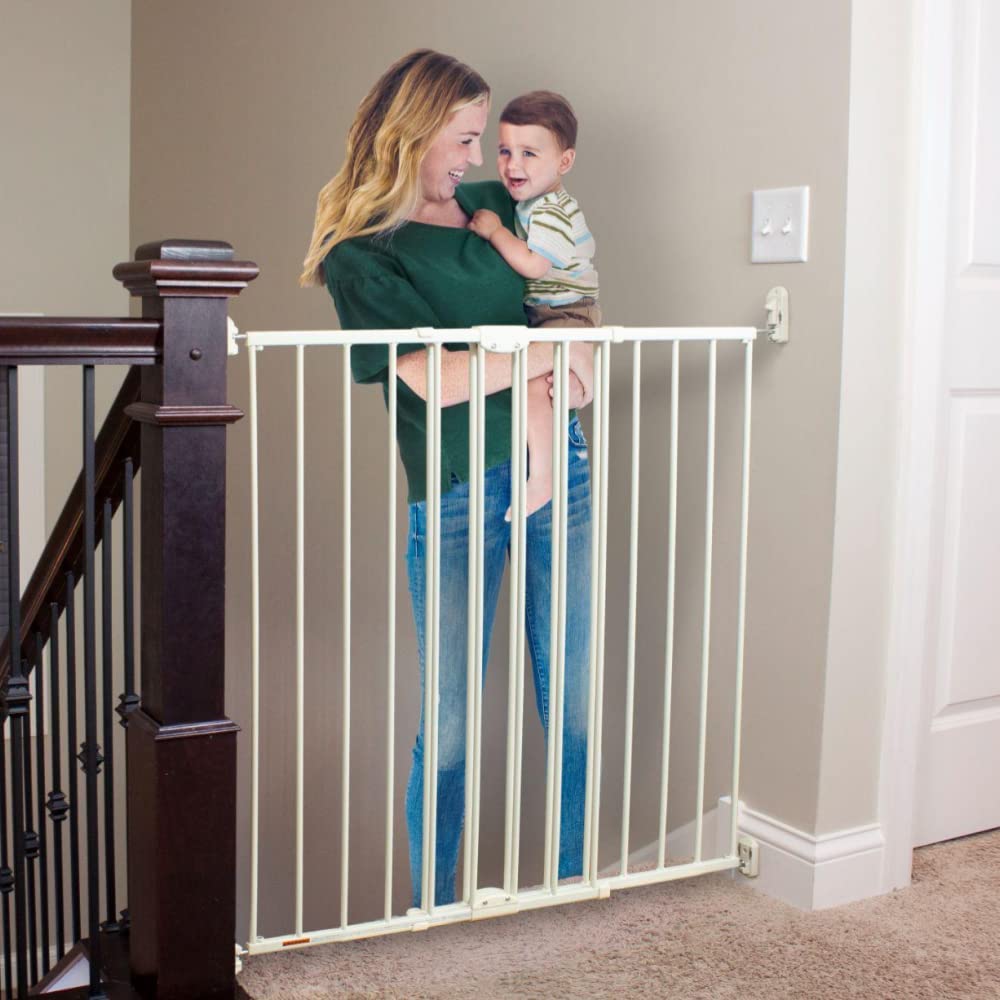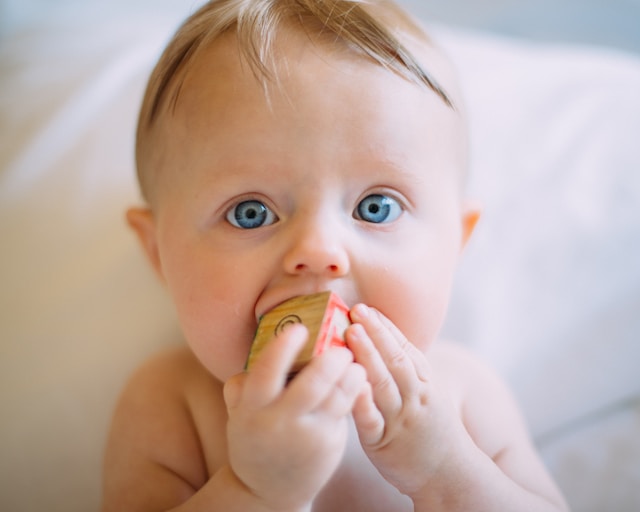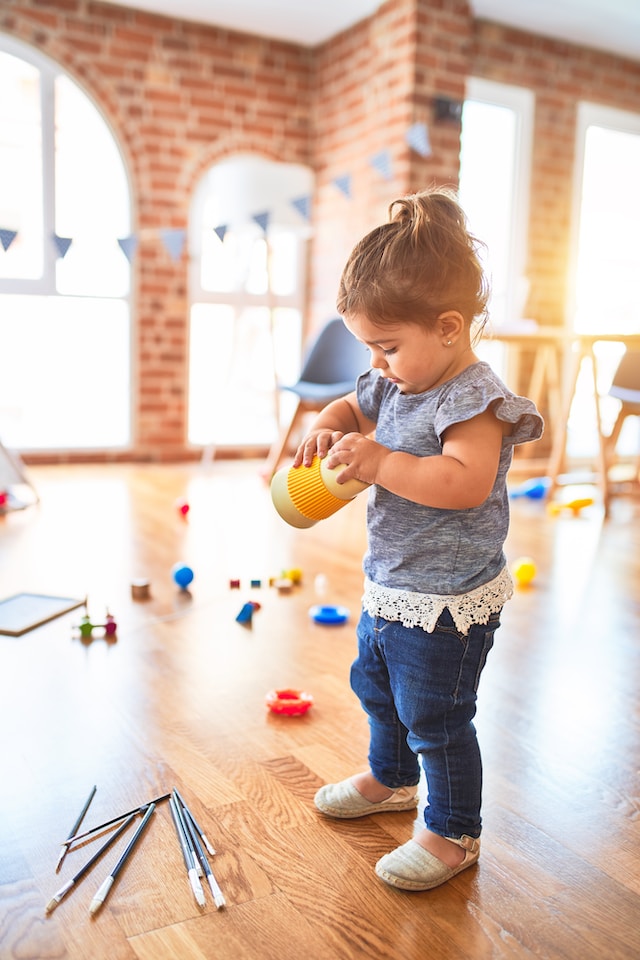One of your top priorities as a parent is keeping your baby safe. Baby gates are a great way to block off dangerous areas of your home, such as the stairs, kitchen, and living room. But where to put a baby gate to keep your baby safe? What are the best places to put a baby gate?
Placing a baby gate strategically in your home effectively keeps your baby safe by restricting their access to certain areas. The specific placement of the baby gate will depend on your home’s layout and safety concerns. Here are some common areas where you might consider placing a baby gate:
Staircase Safety: A Must-Have Placement
Installing baby gates at the top and bottom of staircases is non-negotiable to avoid this heart-stopping scenario. Staircases pose a significant safety risk for babies learning to crawl or walk. Placing a baby gate at the top and bottom of the stairs can prevent falls.
Though they are magnets for exploration but can also be perilous, a secure gate prevents tumbles and gives you peace of mind.
Our top pick to protect your baby from the stairs:
Cardinal Gates Stairway Angle Baby Gate
What makes this gate the absolute best: Based on the unique features of this gate and the fact that 88% of customers rated it 4 or 5 stars, this baby gate stands out from the crowd. It has consistently been a consumer favorite and performs very well overall.
The Heart of the Home: Kitchen Security
The kitchen, a hub of activity, harbors potential hazards like hot surfaces, sharp utensils, and cleaning products. Also, kitchens contain hazards like hot stoves and potentially toxic substances.
Therefore, placing a gate at the entrance to your culinary haven can help keep your baby away from these dangers or ensures your baby’s curious hands stay far from harm. With a gate in place, you can cook, bake, and blend confidently.
Bathrooms: Barrier Against Danger
Bath time is a delightful ritual, but ensuring your baby’s safety amidst slippery surfaces and potential dangers is crucial. A baby gate at the bathroom entrance safeguards your little one from toilets, tubs, and cabinets filled with items that pique their interest but are best left untouched.
Bathrooms can also contain hazards like toilets, water-filled tubs, and sharp corners. Installing a gate to keep your baby out of the bathroom can prevent accidents.
Sanctuaries for Adults: Home Offices and Workspaces
Home offices brim with fascinating gadgets and cords but can also pose risks to curious babies. Placing a gate at the threshold of your workspace keeps your baby out of harm while allowing you to focus on daily tasks.
If you have a home office or workspace with electronics, or other potential dangers, consider using a baby gate to keep your baby out of that area.
Uncharted Territories: Restricted Rooms
Certain rooms might not be baby-friendly due to fragile décor or sensitive belongings. By placing a baby gate at the entrance, you can preserve the sanctity of these spaces while ensuring your baby’s safety.
Consider an area like a gym, guest room, or storage area, a restricted area from your lovely kids. Therefore, you can use a baby gate to block access.
Sanctuary for Fluffy Friends: Pet Zones
Furry family members bring immeasurable joy, but some aspects of their domain, like food bowls and litter boxes, might not be suitable for your baby’s exploration.
If you have pets, use a baby gate to separate your baby from their food and water bowls, litter boxes, or any larger pets your baby might accidentally provoke. Utilize baby gates to create separate zones catering to your baby’s safety and your pets’ comfort. An extra tall baby gate can be helpful for both babies and pets.
Corridor Control: Navigating Hallways
Hallways often lead to multiple rooms, and installing a baby gate can serve as a versatile boundary marker. This approach is beneficial when you want to grant your baby access to some rooms while limiting access to others.
Utility or Laundry Room
Areas with cleaning supplies, appliances, and other potential hazards should be gated off to prevent access.
Hallways
Placing a gate in a hallway can be an excellent option to limit your baby’s access to specific home sections.
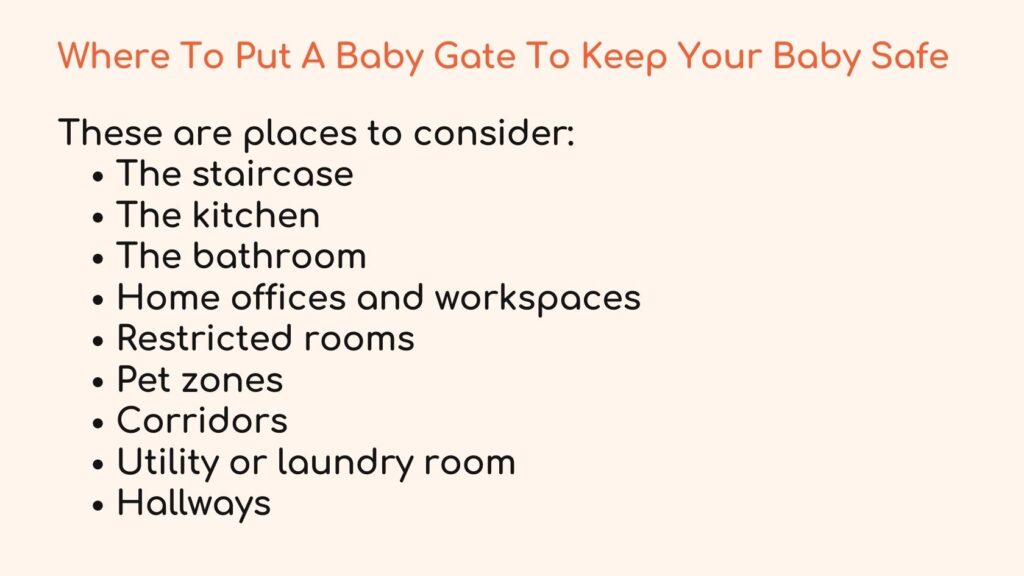
When Placing a Baby Gate: Tips for Choosing a Baby Gate and Where to put a Baby Gate
When it comes to your baby’s safety, every precaution matters. Correctly placing a baby gate is crucial in creating a secure environment that allows your little one to explore while keeping potential hazards at bay.
Below are some essential tips for strategically positioning these gatekeepers of your baby’s world.
Choose a Sturdy Gate: Make sure it is sturdy and securely mounted to prevent your baby from knocking it down or climbing over it.
Measure Properly: Measure the width of the area where you intend to place the gate to ensure a proper fit. Ensure the entrance is the right size to fit the doorway or opening where you want to put it.
Check for Trip Hazards: Avoid placing gates in areas where someone might trip over them.
Easy to Open and Close: Select a gate that you can easily open and close with one hand, as you’ll likely be holding your baby while using it.
Follow Manufacturer’s Instructions: Always follow the manufacturer’s instructions for properly installing and using the baby gate.
Supervision: While baby gates can be beneficial, they are not substitutes for proper care. Always keep an eye on your baby, especially in new environments.
The Safety Features: Ensure the gate has features preventing your baby from climbing over or squeezing through it.
The Durability of the Gate: The gate should be sturdy to withstand your baby’s weight and abuse.
Types of Baby Gates
Baby gates are versatile tools for creating safe spaces in your home. Remember, not all gates are created equal. Depending on your needs and the layout of your home, different types of baby gates offer unique advantages. There are many types of baby gates:
- Pressure-mounted gates (Pressure-mounted gates are easier to install but less secure than hardware-mounted gates)
- Hardware-mounted gates
- Extra tall baby gates
- Retractable gates
- Outdoor baby gates
As your baby grows and explores the world, strategically placing baby gates can balance curiosity and safety. Consider the location, purpose, and layout of the area you’re gating off. These gates are guardians that shield your little one from potential hazards while granting them the freedom to explore within secure boundaries.
Bottom Line
By placing baby gates at staircases, the kitchen, bathrooms, workspaces, pet zones, restricted rooms, and hallways, you create a harmonious living environment that fosters your baby’s growth and discovery.
Remember, while baby gates are essential tools, they complement your vigilant supervision, resulting in a holistic approach that prioritizes your baby’s safety above all else. Begin your journey for the best baby gate here at Baby Gates Expert.

